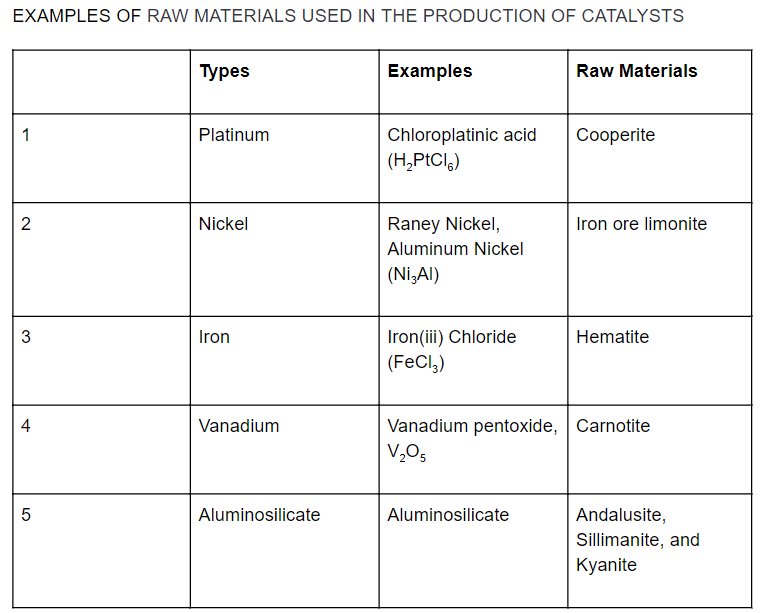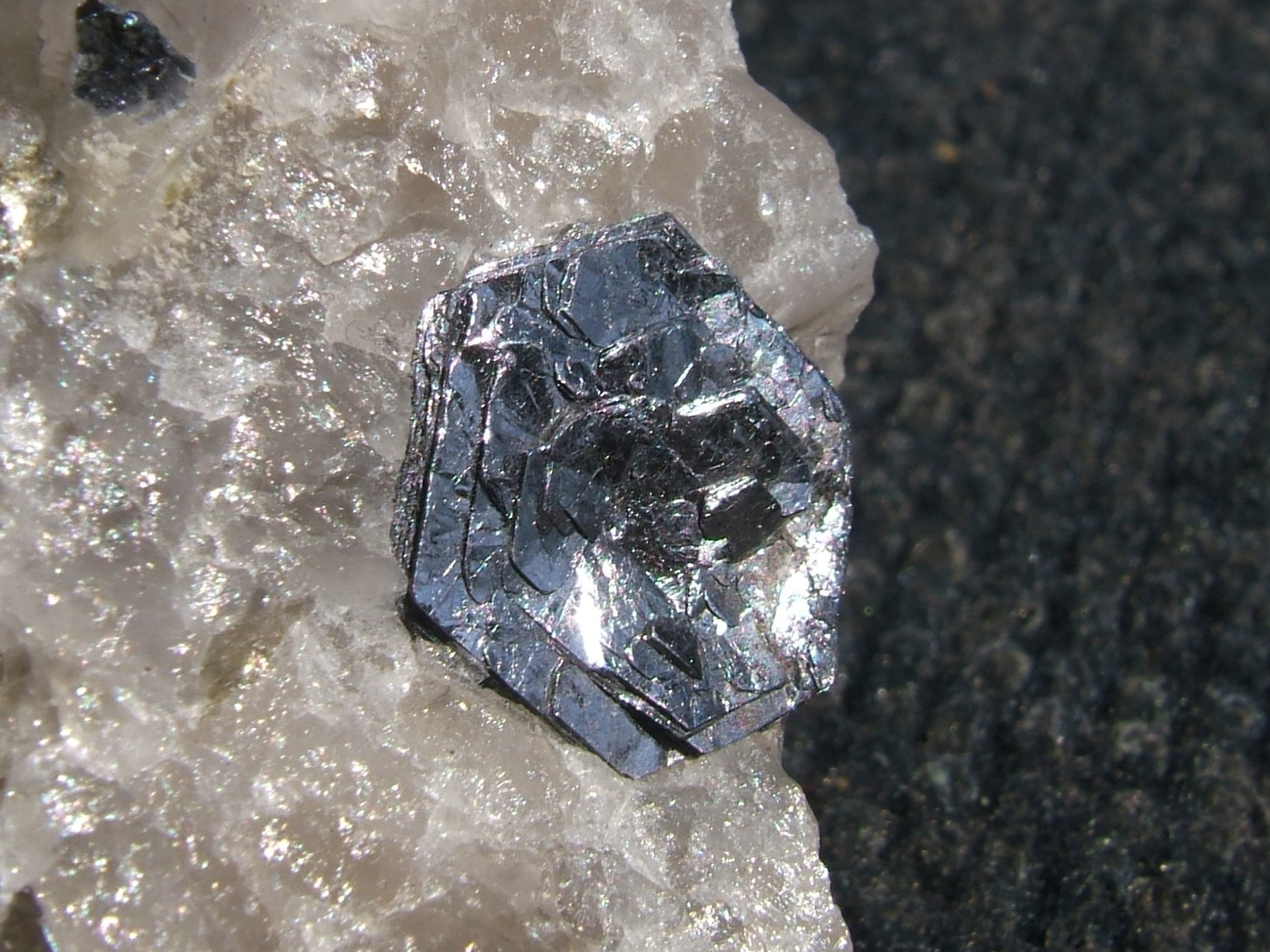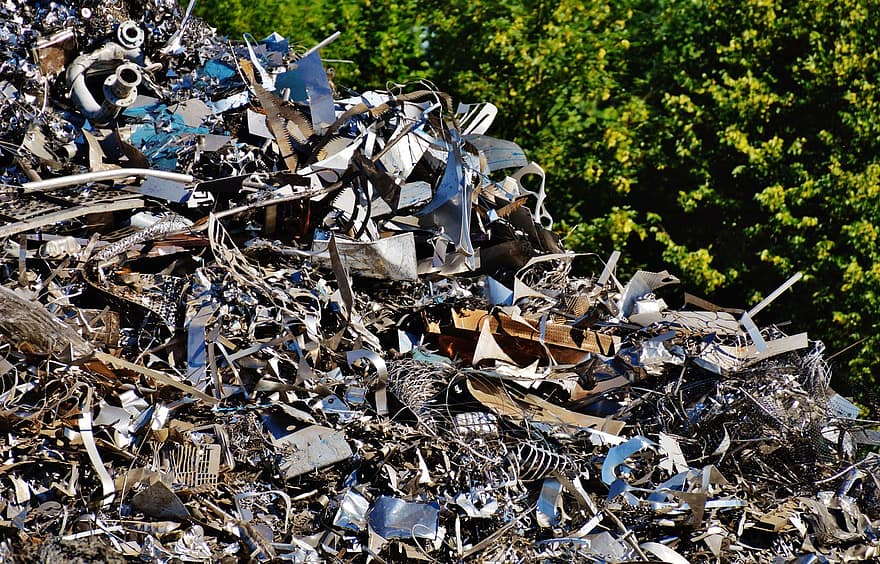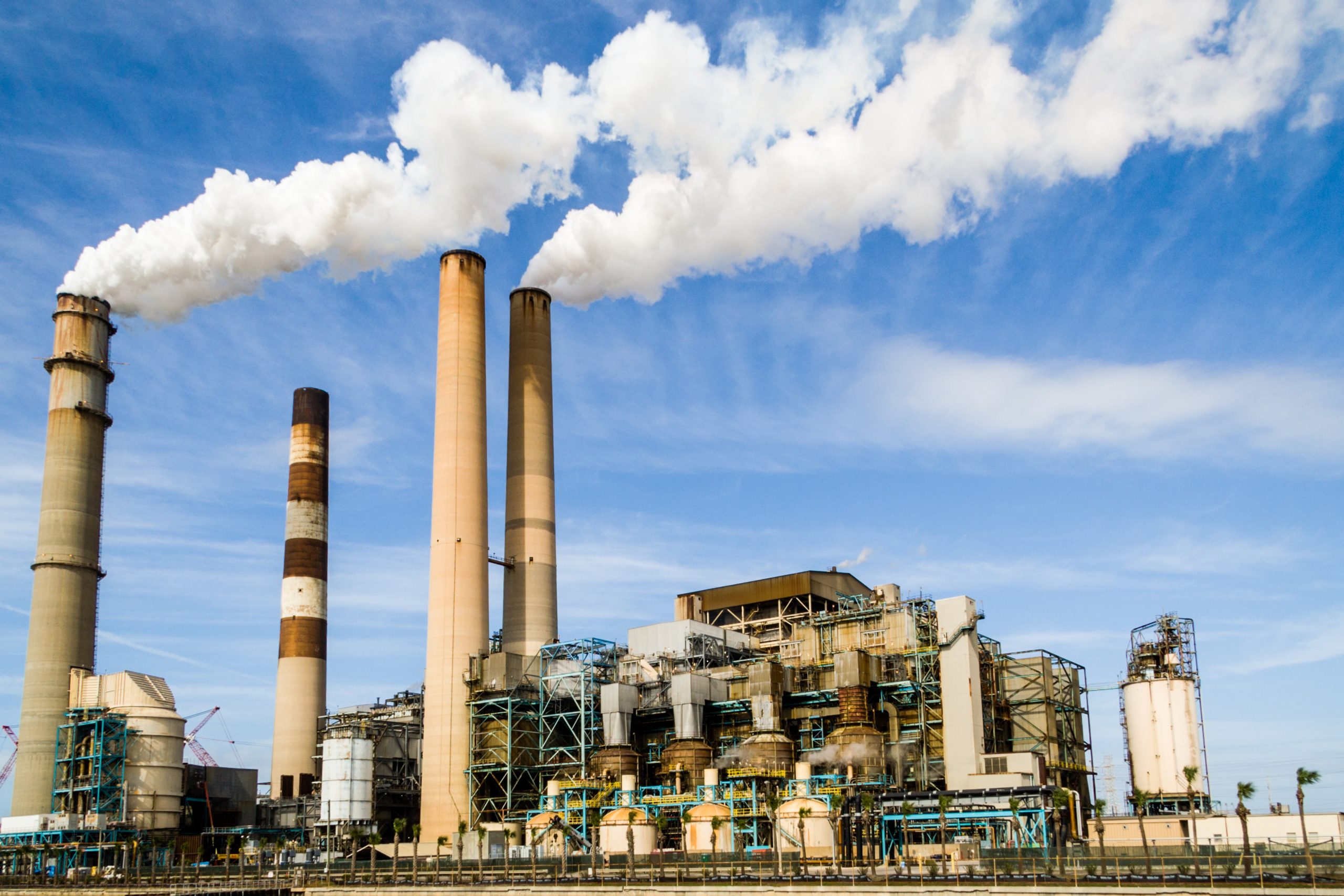RAW MATERIALS USED IN CATALYST
Since catalysts are great for improving the efficiency of industrial activities by reducing the amount of energy and time required to produce various products, it is worthwhile to take a look at the raw materials used in catalysts.
Generally, raw materials are primary and unprocessed materials that are required to form a finished product. They are of great importance because without them, products cannot be formed. Raw materials can be extracted from mining activities from the earth's crust or other natural resources.
An excellent example of a catalyst is the platinum catalyst, which serves as a reforming catalyst in the petroleum industry and also as a catalytic converter in the automobile industry. This occurs by allowing complete combustion of unburnt hydrocarbons from the exhaust into carbon dioxide and water vapor--both of which are harmless to the environment.
Now that we have understood what raw materials are and what catalysts are, let's dive into how catalysts are produced from raw materials.

Catalyst Manufacturing and its Raw Materials
The demand for catalysts in industries is significantly increasing, so it is essential to know how to go about getting these catalysts. According to research, the global sales of both homogeneous and heterogeneous catalysts sum up to tens of billions of dollars per year, and an increase of about 5% is said to occur yearly.
You might be wondering how you can get these catalysts. The answer: you can easily contact raw material sourcing companies. RTS can help you.
As stated earlier, raw materials are unprocessed or basic materials used in the production of a finished product. Anything that goes through a process and results in an end product has used up a primary material. In regards to catalyst, catalysts go through several processes which include:

- Preparation
- Mixing of solution or suspension
- Impregnation
- Washin
- Filtration
- Crystallization
- Drying
- Calcination, among others.
Some chemical catalysts that manufacturing industries use include:
- Platinum
- Nickel
- Iron
- Vanadium
- Aluminosilicate, and so on.
The platinum catalyst, for example, is commonly used as a catalytic converter. Its raw material is the platinum metal. This is rare and exists in some nickel and copper ores along with some native deposits, mostly in South Africa, which accounts for 80% of the world production.
Importance of Catalyst to Industries and Our Environment
The catalyst is an essential component used in industrial processes; both the homogeneous and heterogeneous catalysts have a substantial environmental impact.
The following are some of the reasons why catalysts are important to manufacturing industries:
- The amount of energy and raw materials needed for producing chemicals is significantly reduced by using catalysts.
- Catalysts decrease the activation energy of chemical reactions. They participate in reactions but are neither the reactants nor the products of the reaction they catalyze. An exception is the process of autocatalysis, where the product of a reaction helps to accelerate the same reaction. They work by providing an alternative pathway for the reaction to occur, thus reducing the activation energy and increasing the reaction rate.
- Catalysts reduce the amount of hazardous waste generated by industrial processes, thereby making our environment healthier.
- Catalysts are the backbone for the production of many materials, such as plastics.
- Catalyst converters significantly reduce the air pollution that could be caused by the exhaust of automobiles.
- Platinum catalysts are used in the hydrocracking (breaking long chains of hydrocarbons to shorter ones in the presence of hydrogen and catalyst). This applies to the petroleum industry specifically.
Hydrodesulfurization catalysts are used in yielding cost-effective low-sulfur diesel and gasoline, thereby reducing emissions of sulfur dioxide (SO2) by using those fuels in automobiles, trucks, aircraft, and ships.
Catalysis and its Significant Environmental Application
Catalysis simply refers to an increase or decrease in the rate of a chemical reaction utilizing a substance called a catalyst. Since a catalyst only aids the reaction and doesn't undergo the reaction itself, it is still present after the reaction has occurred. However, it may have lost part or all of its catalytic property due to heat damage and impurities in catalysis.
For instance, a ball left on a field with a slight slope will tend to move slowly down the field. Now imagine if a person kicks the ball, the rate at which the ball is rolling down the field will increase, and it will get to its destination faster. This is the similitude of catalysis where the person that kicked the rolling ball serves as the catalyst, and the rolling ball serves as the chemical reaction.

Catalysis helps reduce the amount of raw material used in production in different manufacturing industries and also reduces the amount of hazardous waste that would be generated after these products are created.
Therefore, catalysis is of great importance in making our environment clean and safe. It also reduces the production price of finished products.
As crucial as catalysis is to us and our environment, the catalysts in use lose their catalytic activities due to exposure to heat during refining and other chemical engineering processes. These catalysts that have used up their catalytic properties are known as spent catalysts and can also pollute our environment.
What is the Fate of a Spent Catalyst?
Since spent catalysts are waste and can be hazardous, what should be done to them? Understanding the specifics about spent catalysts can help you to better understand what should be done with them.
Although, in recent years, the quantity of spent hydroprocessing catalysts disposed of as solid wastes by petroleum refining industries has increased remarkably due to rapid growth in the hydroprocessing capacity to catch up with the increasing demand for low sulfur fuels.
Take, for instance, in Kuwait, around 7,000 tons of spent catalysts are generated yearly as hazardous wastes from the hydrotreating and hydrocracking units. Environmental laws concerning spent catalyst disposal have become stricter in response to this. Spent hydroprocessing catalysts have been classified as hazardous wastes by the Environmental Protection Agency in the USA. The most critical hazardous characteristic of spent hydroprocessing catalysts is their toxic nature.
As a result of their toxic nature, spent hydroprocessing catalysts have been regarded as dangerous wastes, and their refiners are experiencing pressure from environmental authorities to handle them safely. Other methods such as separation of metals, rejuvenation, reuse, safe disposal, and production of useful materials using spent catalysts as raw materials are in use to solve the spent catalyst problem.
Spent catalysts are considered dangerous because chemicals such as Vanadium, Nickel, Molybdenum, and Cobalt that are present in the catalyst can escape into water after disposal and can cause water pollution.
Here at Recognized Trading and Shipping Inc, we buy and ship spent catalysts to Hongjing Resources Co., Ltd, where the metals in them will be separated and used for the production of other products. The residues are treated before disposal.

Refining and Reuse of Spent Catalysts
Aside from the danger that spent catalysts can pose to human health and the environment when managed improperly, there are enormous uses and benefits that can be derived from spent catalysts when recycled by certified agencies like our Korean partner, HongJing Resources Co., Ltd.
Spent catalysts can be fully reused in cement manufacturing, building material, asphalt paving, construction, and so on. The cement industry is known to be one of the main sectors where significant amounts of spent catalyst can be effectively used either as an additive or as a raw material in the manufacturing mixture of tiles.
Some precious metals such as platinum, palladium, and rhodium can also be extracted from spent catalysts. Platinum is used in jewelry, electronics, chemical processing, and some other unique aspects.
If metal contaminants are high in spent catalysts, refining is not a practical process because catalysts are susceptible to irreversible deactivation caused by adsorption of metal impurities, such as Vanadium and Nickel. Regeneration is generally utilized when the metal contaminants are low or negligible on the catalyst.
Spent catalysts can also be regenerated and reused again by restoring their catalytic properties. This is possible when the percentage of metallic contaminants are low in the spent catalysts. The process of catalyst regeneration takes place under highly regulated temperature and chemical treatments.
Other Hazardous Wastes
Hazardous wastes are harmful materials generated as a byproduct of industrial manufacturing processes. These materials have substantial or potential threats to public health or the environment. Some of the hazards caused by these hazardous wastes are listed below
- Ignitability
- Reactivity
- Corrosivity, among others.
For a material to be classified as a hazardous waste, it must first be in the solid-state.
The first step in the hazardous waste identification process is determining if a material is a solid waste.
The second step in this process examines whether or not the waste is expressly excluded from regulation as solid or hazardous waste.
Once we determine that their waste meets the definition of solid waste, we investigate whether or not the waste is listed or characterized as hazardous waste.
Positive Utilization of Hazardous Wastes
Spent catalysts can be used in a way that benefits the environment. Other hazardous wastes can also be converted to precious materials and made useful to us.
Hazardous waste can be in the form of solids, liquids, sludges, or contained gases, and this waste may be generated primarily by chemical production, manufacturing, and other industrial activities.
The process of converting hazardous wastes to useful materials begins with the collection of hazardous waste, thermal and chemical treatment of the waste, and finally, the safe disposal of the trash or recycling the junk to yield other products.
The omission or mismanagement of one of the processes stated above can unleash the hazardous characteristics of the waste.
Therefore, a well experienced and competent company should be responsible to carry out this task to avoid exposing our habitat to danger due to the mismanagement of hazardous wastes.

Let Us Handle the Spent Catalyst For You
Are you worried about the overwhelming laws and fees required for the disposal of your spent catalyst? If yes, relax, as we are here to help.
We buy your industrial wastes from you and transport it to our partner HongJing Resources in the Republic of Korea. They specialize in recycling hazardous wastes in the most environmentally friendly way.
Being an international company, we will file the waste notice to various competent authorities on your behalf and act as the exporter of the waste for recovery.
We manage your industrial wastes by collecting, transporting, extracting, and recycling them, while abiding by all national and international regulations that govern the transportation of industrial wastes.
Over the years, we have successfully bought and shipped hazardous wastes containing metals to Hongjing Resource Co. Ltd. for recycling.
We have been in the business of buying and shipping waste internationally for recovery for over fifteen years, abiding by the laws associated with the transboundary movement. We can assure you perfect shipping and recovery of hazardous waste in a way that will benefit our environment.
You can always trust us with your spent catalyst and other industrial wastes.
Get in touch with us today, and we will make beneficial use of your spent catalyst and dispose of the residue in an environmentally friendly way.



